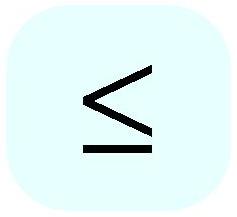

- #Greater than or equal to symbol in microsoft word pro
- #Greater than or equal to symbol in microsoft word code
- #Greater than or equal to symbol in microsoft word iso
- #Greater than or equal to symbol in microsoft word free
#Greater than or equal to symbol in microsoft word code
Overprinting was intended to work by putting a backspace code between the codes for letter and diacritic.
#Greater than or equal to symbol in microsoft word iso
ISO 646 and ASCII incorporated many of the overprinting lower-case diacritics from typewriters, including tilde. Thus ISO 646 was born (and the ASCII standard updated to X3.64-1967), providing the tilde and other symbols as optional characters.
#Greater than or equal to symbol in microsoft word free
Yucca's free information site (which cites the original sources). At the October 29–31 meeting, then, the ISO subcommittee altered the ISO draft to meet the CCITT requirements, replacing the up-arrow and left-arrow with diacriticals, adding diacritical meanings to the apostrophe and quotation mark, and making the number sign a dual for the tilde. It appears to have been at their May 13–15, 1963 meeting that the CCITT decided that the proposed ISO 7-bit code standard would be suitable for their needs if a lower case alphabet and five diacritical marks were added to it. The ASA worked with and through the CCITT to internationalize the code-set, to meet the basic needs of at least the Western European languages. : 246 Like Portuguese and Spanish, the French, German and Scandinavian languages also needed symbols in excess of the basic 26 needed for English. The first ASCII standard (X3.64-1963) did not have a tilde. The centralized ASCII tilde Serif:Ī free-standing tilde between two em dashes

The tilde symbol did not exist independently as a movable type or hot-lead printing character since the type cases for Spanish or Portuguese would include sorts for the accented forms. Typewriters for Spanish typically have a dedicated key for Ñ/ñ but, as Portuguese uses Ã/ã and Õ/õ, a single dead-key (rather than take two keys to dedicate) is the most practical solution. With the latter, a mark is made when a dead key is typed, but unlike normal keys, the paper carriage does not move on and thus the next letter to be typed is printed under that accent. Keys can be dedicated to precomposed characters or alternatively a dead key mechanism can be provided. On typewriters designed for languages that routinely use diacritics (accent marks), there are two possible solutions. Ñ/ñ is present as a precomposed character only. Role of mechanical typewriters įurther information: Dead key and Diacritic An Olivetti Lettera 32 typewriter (Portuguese Model) with tilde (and circumflex) dead-key beside Ç Spanish typewriter (QWERTY keyboard) with dead keys for acute, circumflex, diaeresis and grave accents. Ipsi manerio pertinet tercius denarius de Hundredis Nortmoltone et Badentone et Brantone et tercium animal pasturae morarum. Eidem manerio est injuste adjuncta Nimete et valet quindecim solidos. Valet viginti solidos ad pensam et arsuram.

#Greater than or equal to symbol in microsoft word pro
Elwardus tenebat tempore regis Edwardi pro manerio et geldabat pro dimidia hida. Reddit quattuor et viginti libras ad pensam. Pastura tres leugae in longitudine et latitudine. Ibi duodecim acrae prati et quindecim acrae silvae. In dominio sunt tres carucae et decem servi et triginta villani et viginti bordarii cum sedecim carucis. Mollande tempore regis Edwardi geldabat pro quattuor hidis et uno ferling. The text with abbreviations expanded is as follows: The text of the Domesday Book of 1086, relating for example, to the manor of Molland in Devon (see adjacent picture), is highly abbreviated as indicated by numerous tildes. Medieval European charters written in Latin are largely made up of such abbreviated words with suspension marks and other abbreviations only uncommon words were given in full. This saved on the expense of the scribe's labor and the cost of vellum and ink. Such a mark could denote the omission of one letter or several letters. Thus, the commonly used words Anno Domini were frequently abbreviated to A o Dñi, with an elevated terminal with a suspension mark placed over the "n". The tilde was originally written over an omitted letter or several letters as a scribal abbreviation, or "mark of suspension" and "mark of contraction", shown as a straight line when used with capitals. Its primary use is as a diacritic (accent) in combination with a base letter but, for historical reasons, it is also used in standalone form within a variety of contexts. The name of the character came into English from Spanish, which in turn came from the Latin titulus, meaning "title" or "superscription". The tilde ( / ˈ t ɪ l d eɪ, - d i, - d ə, ˈ t ɪ l d/) ˜ or ~, is a grapheme with a number of uses. For the notations ⟨ ⟩, / / and used in this article, see IPA Brackets and transcription delimiters. This page uses orthographic and related notations.


 0 kommentar(er)
0 kommentar(er)
